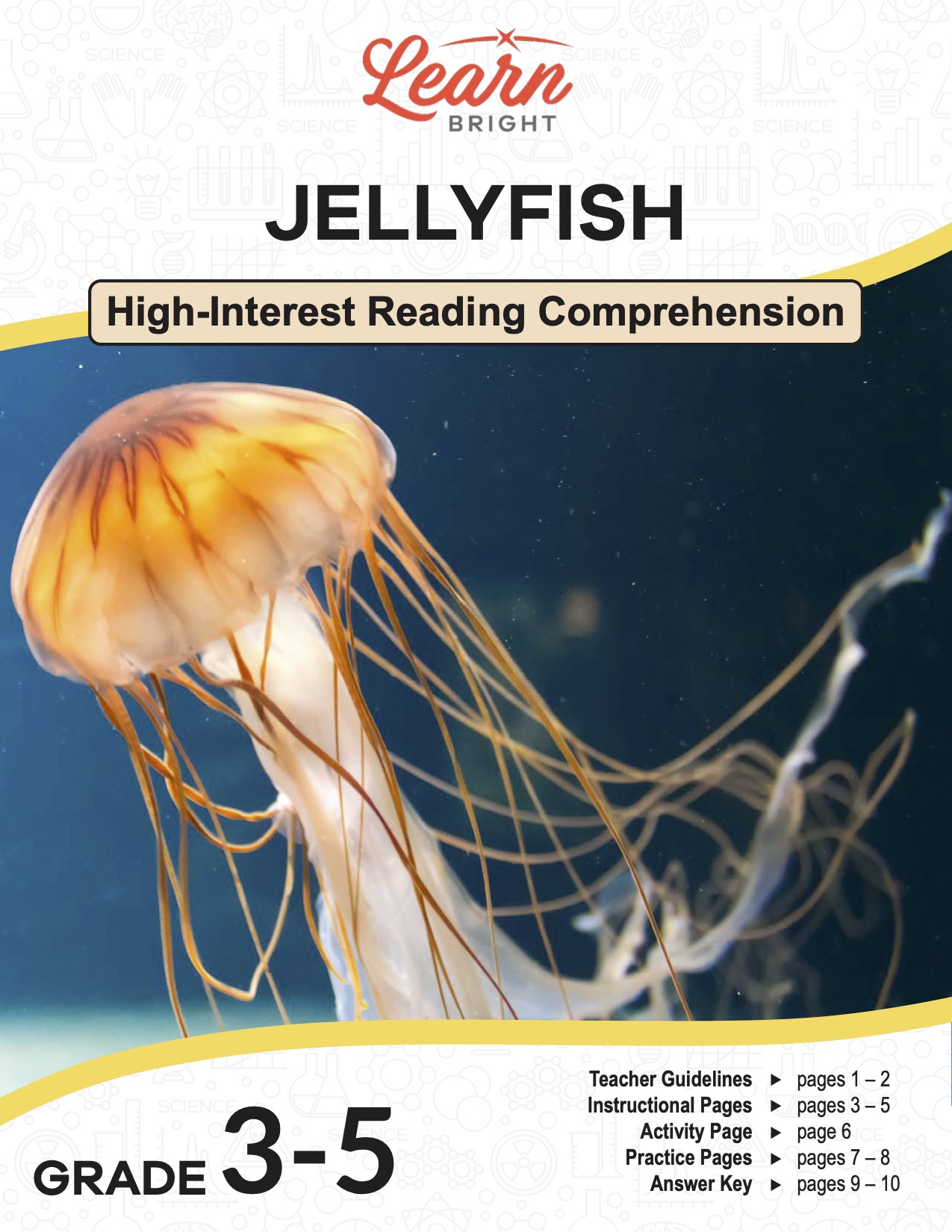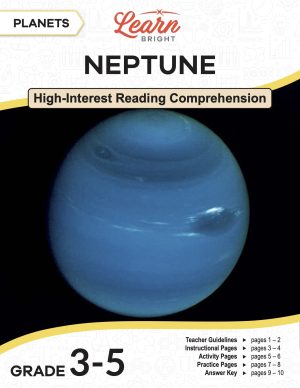Description
What our Jellyfish lesson plan includes
Lesson Objectives and Overview: Jellyfish is a high-interest reading comprehension lesson plan. As such, students will practice various close reading and comprehension skills. In addition, they will learn about the habitat, diet, and behaviors of jellyfish. This lesson is for students in 3rd grade, 4th grade, and 5th grade.
Classroom Procedure
Every lesson plan provides you with a classroom procedure page that outlines a step-by-step guide to follow. You do not have to follow the guide exactly. The guide helps you organize the lesson and details when to hand out worksheets. It also lists information in the yellow box that you might find useful. You will find the lesson objectives, state standards, and number of class sessions the lesson should take to complete in this area. In addition, it describes the supplies you will need as well as what and how you need to prepare beforehand. This lesson requires white construction paper, watercolor paints, brushes (or markers), glue, various colors of tissue paper, scissors, pencils, and googly eyes (optional) for the activity.
Teacher Notes
The teacher notes page provides an extra paragraph of information to help guide the lesson. It explains that you can teach this lesson in a whole-class setting or as an independent, small-group activity. You can use the blank lines to write down any other ideas or thoughts you have about the topic as you prepare.
JELLYFISH LESSON PLAN CONTENT PAGES
What Is a Jellyfish?
The Jellyfish lesson plan contains three content pages. It begins by providing a box of background information about this cool invertebrate animal. These invertebrates live in every ocean of the world. They primarily eat plankton and small fish, and they only live for up to about three years.
Jellyfish are incredible creatures that live in the world’s oceans. They have unique physical characteristics that set them apart from other animals. Jellyfish are made up of a soft, gelatinous material and have a nearly transparent body. They don’t have bones, a brain, or a heart. Instead, they have a simple nervous system that helps them sense their environment.
What makes jellyfish even more fascinating is their graceful appearance as they move through the water, using a bell-shaped body and long, trailing tentacles. Jellyfish tentacles are like long, flowing ribbons in the water. These tentacles are filled with tiny stinging cells called cnidocytes, which they use to capture their food.
Usually, jellyfish are solitary creatures, which means they like to live alone. However, they can sometimes gather in groups called blooms when conditions in the ocean are just right. In blooms, lots of jellyfish swim around together. Some jellyfish prefer to float near the ocean’s surface while others prefer to stay deeper. They can be found in oceans worldwide, from the cold waters near the poles to the warm waters near the equator.
What They Eat
The diet of a jellyfish typically includes small animals like tiny fish, shrimp, zooplankton, and even baby jellyfish. But jellyfish have a unique way of getting their food. They don’t use a knife and fork to eat their meals like we do. Instead, they have stinging tentacles that look like long, slimy arms, covered in tiny stingers called cnidocytes.
When a jellyfish is hungry, it stretches its tentacles out in the water. When a small animal like a plankton or a tiny fish touches these tentacles, the stinging cells shoot out tiny harpoons filled with venom. The venom paralyzes or stuns the prey, making it easier for the jellyfish to catch and eat. The tentacles pull the prey into the jellyfish’s mouth, which is in the middle of its body. Inside its body, the jellyfish digests its food and turns it into energy to keep swimming and stay alive.
Other Interesting Facts
Jellyfish have an interesting life cycle. After they lay their eggs, the eggs hatch into tiny larvae that eventually settle on the ocean floor and grow into polyps. Polyps attach themselves to rocks or other surfaces and look like small tubes or columns. They can actually reproduce asexually, meaning they can make exact copies of themselves. This is called budding. When the conditions are right, polyps can bud and create new jellyfish without laying eggs. It’s a very different way of growing up compared to mammals like us, but it works well for these interesting sea creatures in their underwater world.
Jellyfish are the ancient explorers of the ocean. Scientists believe they have been drifting through the world’s oceans for hundreds of millions of years, even before the dinosaurs lived! Imagine these creatures floating and swimming around in the seas long before humans or many other animals existed on Earth. It’s like they have a secret history hidden beneath the waves.
When jellyfish move through the water, they look like they’re dancing in slow motion. Their bell-shaped bodies pulse rhythmically, propelling them forward in a mesmerizing way. These graceful movements help them find food and avoid predators.
Some jellyfish have a magical trick up their sleeves—or rather, up their tentacles. They can glow in the dark! This glow, called bioluminescence, happens when special cells in their body create light. It’s like having their very own built-in nightlight. They use this glow to attract prey and sometimes to scare away predators. In other words, they can look amazing both day and night as they light up the deep, dark ocean.
Jellyfish and the Environment
Jellyfish may seem like simple creatures, but they play an essential role in the ocean’s ecosystem. One of the things they do is help keep the balance of other animals in check. They eat small fish and tiny creatures called zooplankton. If there were too many small fish and zooplankton in the ocean, they could overeat the plants that grow in the water, which would upset the balance of the entire ocean. Jellyfish help make sure everything stays in harmony.
Most jellyfish are not endangered like some other animals. In fact, they can be found in oceans all around the world. However, some scientists are studying jellyfish more closely because they seem to increase in certain areas. This might be because of changes in the ocean due to climate change and pollution. So while jellyfish are not endangered, they can tell us important things about the health of our oceans. We must take good care of the oceans to keep all its creatures, including jellyfish, safe and happy.
JELLYFISH LESSON PLAN WORKSHEETS
The Jellyfish lesson plan includes two worksheets: an activity worksheet and a practice worksheet. Each one will help students solidify their grasp of the material they learned throughout the lesson. You can refer to the classroom procedure guidelines to know when to hand out each worksheet.
JELLYFISH ART ACTIVITY WORKSHEET
For the activity, students will create works of jellyfish art! They will first draw a jellyfish on some white construction paper. They can get creative as they want with the size and shape of their animal, as well as the color. You will provide other materials for students to use for the tentacles and googly eyes. After they finish, students will write a scientific name for their jellyfish at the top of the paper.
COMPREHENSION REVIEW PRACTICE WORKSHEET
The practice worksheet requires students to answer a series of 11 questions. These questions all relate to the content pages, so students will need to refer to them to find the answers. In addition, each question provides which reading tool the question corresponds to, such as text feature, vocabulary, or comprehension.
Worksheet Answer Keys
At the end of the lesson plan document is an answer key for the practice worksheet. The correct answers are all in red to make it easier for you to compare them with students’ responses. If you choose to administer the lesson pages to your students via PDF, you will need to save a new file that omits these pages. Otherwise, you can simply print out the applicable pages and keep these as reference for yourself when grading assignments.









